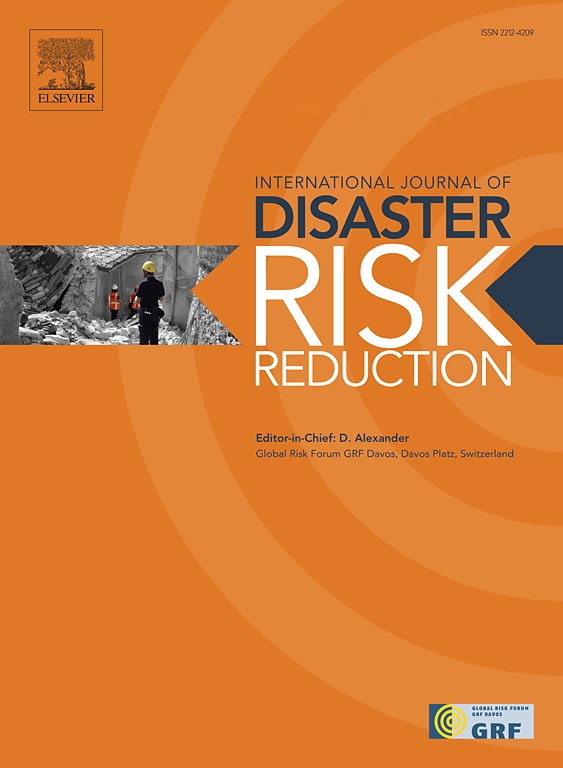IF 4.2
1区 地球科学
Q1 GEOSCIENCES, MULTIDISCIPLINARY
International journal of disaster risk reduction
Pub Date : 2025-03-28
DOI:10.1016/j.ijdrr.2025.105437
引用次数: 0
摘要
山洪暴发具有强烈的突发性,给灾害研究人员和应急规划人员带来了独特的挑战。为了量化受山洪暴发影响的地区在多大程度上具有相似的社会和自然特征,这项研究使用了社区规模的开源和众包数据以及 k-means 聚类方法。众包数据有助于揭示一个社区在社会和自然方面易受山洪影响的程度,这可以更好地为决策者提供信息,因为他们必须分配有限的资源,了解空间情况,并致力于减少山洪对未来的影响。这项研究评估了热带风暴伊梅尔达对休斯顿大都市和飓风艾达对纽约市的影响。它基于联邦紧急事务管理局的索赔、311 电话和 Waze 交通报告,开发了一个综合的山洪影响指数,该指数能够捕捉山洪对社会影响的众包数据组合。K-means 聚类法根据综合洪水影响指数对社区的社会人口、社会资本和物理特征进行评估。为了确保不同类型社区的可访问性和可复制性,我们的研究使用了公开可用的数据集,以了解社会人口数据、社会资本以及物理连接和发展如何影响山洪灾害的抵御能力。研究结果提供了一个利用历史数据识别潜在洪水影响的框架。本文章由计算机程序翻译,如有差异,请以英文原文为准。
Analyzing common social and physical features of flash-flood vulnerability in urban areas
Flash flooding events, with their intense and sudden nature, present unique challenges for disaster researchers and emergency planners. To quantify the extent to which areas impacted by flash flooding share similar social and physical features, the research uses community-scale open-source and crowdsourced data and k-means clustering. Crowdsourced data helps reveal the social and physical vulnerabilities of a community to flash flood impacts which could better inform decision-makers who must allocate limited resources, have a spatial understanding, and aim to reduce future effects of flash floods. The research evaluates the impacts of Tropical Storm Imelda on Houston Metropolitan and Hurricane Ida on New York City. It develops a combined flash flood impact index based on FEMA claims, 311 calls, and Waze traffic reports which is able to capture a combination of crowdsourced data for the societal impact of flash flooding. K-means clustering evaluates a community's socio-demographic, social capital, and physical features to the combined flood impact index. To ensure accessibility and replicability to different types of communities, our research uses publicly available datasets to understand how socio-demographic data, social capital, and physical connectivity and development affect flash flood resilience. The findings provide a framework to identify potential flood impacts using historic data.
求助全文
通过发布文献求助,成功后即可免费获取论文全文。
去求助
来源期刊

International journal of disaster risk reduction
GEOSCIENCES, MULTIDISCIPLINARYMETEOROLOGY-METEOROLOGY & ATMOSPHERIC SCIENCES
CiteScore
8.70
自引率
18.00%
发文量
688
审稿时长
79 days
期刊介绍:
The International Journal of Disaster Risk Reduction (IJDRR) is the journal for researchers, policymakers and practitioners across diverse disciplines: earth sciences and their implications; environmental sciences; engineering; urban studies; geography; and the social sciences. IJDRR publishes fundamental and applied research, critical reviews, policy papers and case studies with a particular focus on multi-disciplinary research that aims to reduce the impact of natural, technological, social and intentional disasters. IJDRR stimulates exchange of ideas and knowledge transfer on disaster research, mitigation, adaptation, prevention and risk reduction at all geographical scales: local, national and international.
Key topics:-
-multifaceted disaster and cascading disasters
-the development of disaster risk reduction strategies and techniques
-discussion and development of effective warning and educational systems for risk management at all levels
-disasters associated with climate change
-vulnerability analysis and vulnerability trends
-emerging risks
-resilience against disasters.
The journal particularly encourages papers that approach risk from a multi-disciplinary perspective.
 求助内容:
求助内容: 应助结果提醒方式:
应助结果提醒方式:


